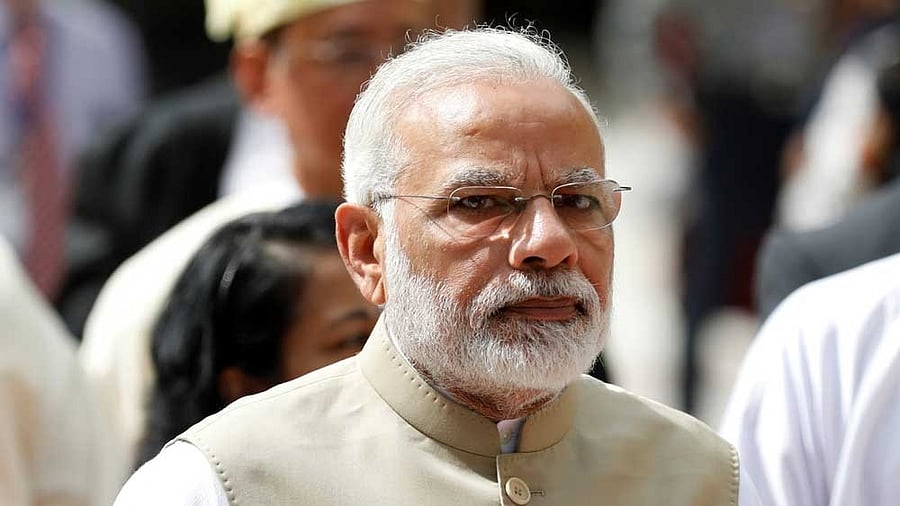
Prime Minister Narendra Modi.
Credit: Reuters File Photo.
The flavour of the season is ‘One Nation, One Election’ (ONOE) — and it is a manufactured one. It’s a time-tested diversionary tactic.
It’s an attempt to divert public attention away from debating the electoral prospects of the Opposition alliance I.N.D.I.A. It’s a ploy to project the Prime Minister as a visionary who always thinks big. It’s a tactic to change the people’s perception about the failures of the Narendra Modi government, to not let people think how price rise is hitting the roof and unemployment is skyrocketing. The meeting of 28 political parties and its cohesion is the first serious threat to the Modi government and its continuance beyond the 2024 general election.
Rejecting UPA
The Bharatiya Janata Party (BJP) is aware that the 2014 general elections were not to choose Modi but to reject the Manmohan Singh government; it was a revolt against corruption, and it was an attempt to teach a lesson to the Congress that it could not take the people for granted. If 2014 was a robust assertion of an aspirational India, the 2019 general elections were a referendum on hyper-nationalism, laced with militarism, and one-ness of the nation against Pakistan’s dirty tricks.
The 2014 and 2019 elections were guided more by emotions. The people were unhappy with the Congress-led Untied Progressive Alliance (UPA) and felt cheated by an honest Prime Minister. It was the same Singh government which had improved its tally in the Lok Sabha in 2009, because people perceived that the government was working for their betterment. The average household income was rising. The UPA-1 years (2004-2009) were good on the economic front.
However, UPA-2 was marred by missed opportunities, arrogance of power, and scams of astronomical proportion. After the Anna Hazare movement, the government was listless. The people were angry, and the Congress was voted out with a vengeance, it’s tally being reduced to below 50 seats in the Lok Sabha in 2014.
Disillusionment
Modi came to power with a huge mandate, and emerged as a symbol of hope. It just took a few of his polices, like demonetisation, and the rise in unemployment to break the myth. By 2018, the disillusionment started setting in. In 2017, the BJP was in a bad state, narrowly saving its government in Gujarat; in 2018, it failed to get a majority in Karnataka and lost to the Congress the elections in Madhya Pradesh, Rajasthan, and Chhattisgarh.
At that time a few top BJP leaders told this author that they did not expect the party to win more than 240 seats in the Lok Sabha. Two months before the 2019 general elections, the Pulwama terror attack claimed the lives of 40 CRPF jawans. The Indian armed forces gave a befitting reply destroying terrorist hideouts in Balakot. Following this, the national mood changed in favour of the ruling party, and the BJP retained power, this time improving its numbers in the Lok Sabha.
Disappointing numbers
In a recent survey, 72 per cent people said that unemployment is a serious issue; for 56 per cent it is ‘very serious’; and, 62 per cent believe that in comparison to last year it has become difficult to manage daily expenses. Despite all the talk about poor and labharthi schemes, 55 per cent said that big business has benefited from Modi’s economic policies, and only 6 per cent believe that daily wagers are the real beneficiaries of this government’s policies.
These are disappointing numbers, especially with the national elections in less than a year, though the same survey also underlines that Modi’s popularity is still high and his government’s approval rating is good.
Uneasiness
Modi has sensed that the 2024 polls is unlike the previous two, and that more effort needs to be put in to form the government for the third time. Two factors are working against him. The first is anti-incumbency. Ten years is a long time in power, and even the best of efforts might seem short of the changing aspirations of the people. No leader, believing in their popularity, can take the elections lightly. In the 2004 polls, then Prime Minister Atal Bihari Vajpayee fell victim to this.
Second, Opposition unity has always damaged the governments in power; the scale of damage varying over the years. In this context, the swift formation of I.N.D.I.A and its cohesion is likely to have unnerved the Prime Minister. The sudden reduction in the price of LPG cylinders a day before I.N.D.I.A’s Mumbai meet is a sign of nervousness. Calling a special Parliament session without disclosing the reason is another one. The biggest of all is the formation of the panel to assess the feasibility of ONOE.
Not that easy
ONOE is a good concept, but its implementation is a humongous task. To have simultaneous elections to Parliament and assemblies, and to local bodies, it requires re-structuring of the political and electoral spectrum. The key to this exercise is fixed and unalterable tenure of these houses of representatives.
To implement ONOE, many assemblies would need to be dissolved mid-term to sync their terms. Constitutional amendments need to be passed to ensure that Parliament or assemblies or local bodies are not prematurely terminated. This is easier said than done.
If the government is the creation of the legislature, its life depends on the majority it enjoys among the elected representatives. A constitutional amendment is a herculean task and almost every party must be on board to carry out such an amendment.
Without this, no government can move towards implementing ONOE plan. Therefore, the announcement of the panel at a time when assembly elections in five states are around the corner, seems farcical as this government neither has the mandate nor required numbers to alter the Constitution.
(Ashutosh is Editor, Satyahindi, and author of Hindu Rashtra.)
Disclaimer: The views expressed above are the author's own. They do not necessarily reflect the views of DH